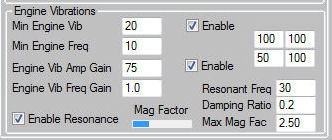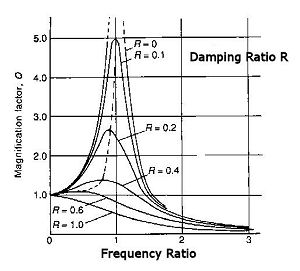Previous
Contents
Next
Appendix 3. Engine Vibration Resonance Effects
 Version 1.5 of the Shaker software
adds engine vibration resonance effects. Version 1.5 of the Shaker software
adds engine vibration resonance effects.
In some aircraft powering-up the engines may cause
higher vibration magnitudes at lower than maximum speeds as a result
of the engine running frequency passing through resonant frequencies
of the supporting airframe.
This effect is modelled in V1.5 by adding a simple
forced damped vibration model to the engine vibration output.
When enabled the engine vibration strength is
magnified as the engine frequency increases with engine speed and
approaches and passes through the damped natural frequency of the
structure. The response is as shown in the graph below - it shows
magnification factor v frequency ratio.

Frequency Ratio is the ratio of current engine
vibration frequency to the specified resonant frequency.
There are
two user settings:
1. Damping
Ratio: this sets how much damping is in the system and is typically
in the range 0.1 to 1.0. It controls the size of the magnification
factor Q.
Smaller
values indicate weaker damping and therefore higher peak vibration
amplitudes (see the effect of different R values in the graph).
When this
setting is changed the Maximum Magnification Factor is recalculated
and displayed (Max Mag Fac). This can be used as a guide to help
choose your damping ratio.
2.
Resonant Frequency (Hz): Set this to define the approximate
frequency at which the magnification will be strongest.
(Tip: observe the frequency (CPS) of the engine vibrations whilst
running up the engines to see the possible range for this setting.)
At lower values of Damping Ratio (smaller R) the point of maximum
magnification will be close to the specified resonant frequency (see
the dotted line in the graph), however as damping ratio approaches
1.0 the point of maximum magnification drops below the resonant
frequency.
For the
purposes of this application the magnification factor is capped at
5.0. This puts a limit on very high peaks that are simply clipped by
the driver card.
NOTE: the
base vibration amplitude remains as normally calculated - ie
amplitude is proportional to engine fuel flow (this is a proxy for
engine power). Vibration frequency is proportional to engine speed.
When resonance is enabled the final output vibration amplitude is then
the base amplitude x the
magnification factor.
The live
magnification factor is displayed in the blue progress bar.
The
overall effect of the feature can be to produce an engine vibration
feel which is stronger at lower engine speed and then reduces when
the engine reaches normal operating speeds. This is most noticeable
when powering-up the engines for take-off.
Previous
Contents
Next
|